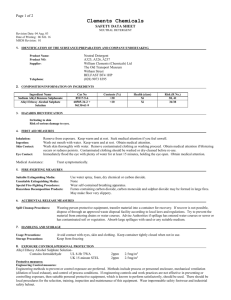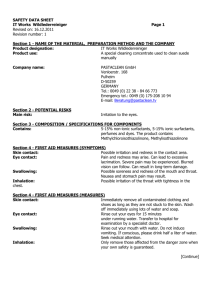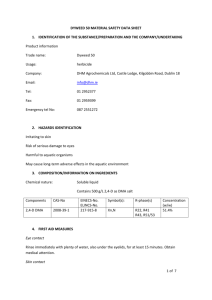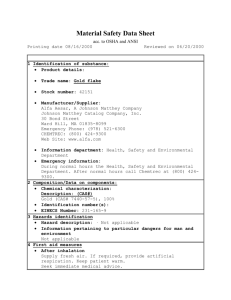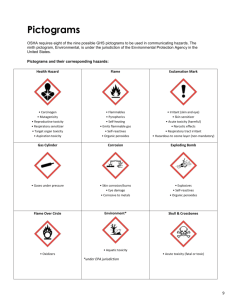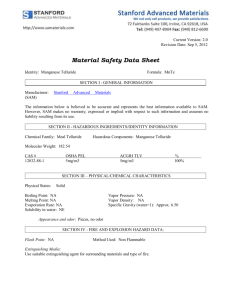물질안전보건자료(MSDS) - LG화학 Chemwide
advertisement
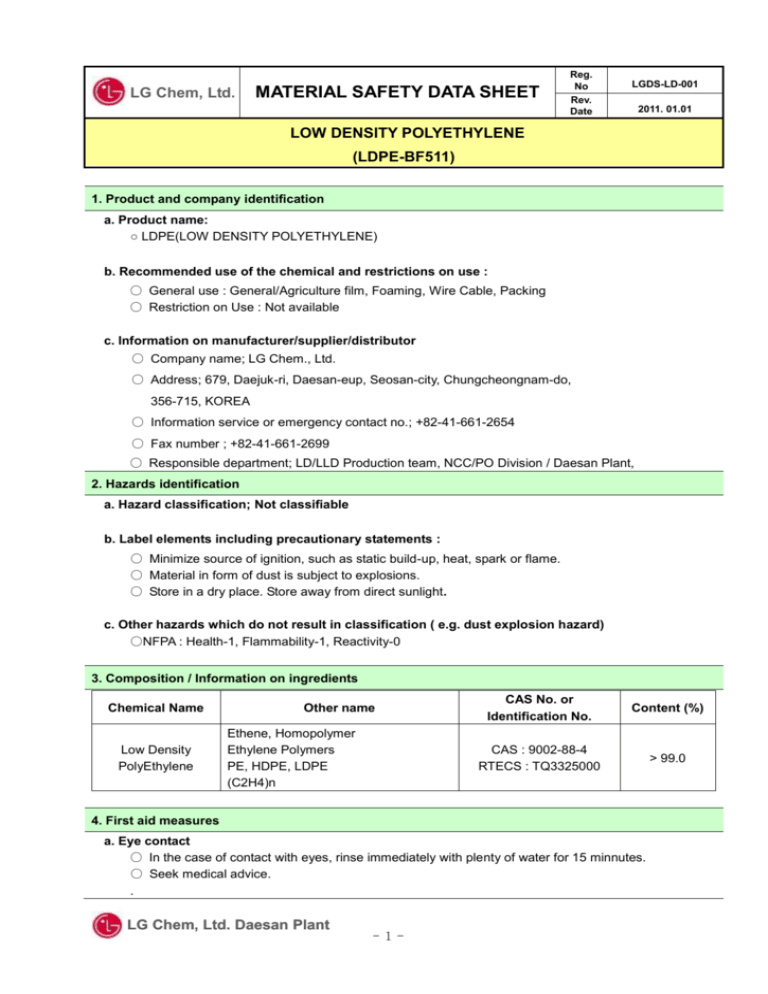
LG Chem, Ltd. MATERIAL SAFETY DATA SHEET Reg. No Rev. Date LGDS-LD-001 2011. 01.01 LOW DENSITY POLYETHYLENE (LDPE-BF511) 1. Product and company identification a. Product name: ○ LDPE(LOW DENSITY POLYETHYLENE) b. Recommended use of the chemical and restrictions on use : ○ General use : General/Agriculture film, Foaming, Wire Cable, Packing ○ Restriction on Use : Not available c. Information on manufacturer/supplier/distributor ○ Company name; LG Chem., Ltd. ○ Address; 679, Daejuk-ri, Daesan-eup, Seosan-city, Chungcheongnam-do, 356-715, KOREA ○ Information service or emergency contact no.; +82-41-661-2654 ○ Fax number ; +82-41-661-2699 ○ Responsible department; LD/LLD Production team, NCC/PO Division / Daesan Plant, 2. Hazards identification a. Hazard classification; Not classifiable b. Label elements including precautionary statements : ○ Minimize source of ignition, such as static build-up, heat, spark or flame. ○ Material in form of dust is subject to explosions. ○ Store in a dry place. Store away from direct sunlight. c. Other hazards which do not result in classification ( e.g. dust explosion hazard) ○NFPA : Health-1, Flammability-1, Reactivity-0 3. Composition / Information on ingredients Chemical Name Low Density PolyEthylene Other name Ethene, Homopolymer Ethylene Polymers PE, HDPE, LDPE (C2H4)n CAS No. or Identification No. Content (%) CAS : 9002-88-4 RTECS : TQ3325000 > 99.0 4. First aid measures a. Eye contact ○ In the case of contact with eyes, rinse immediately with plenty of water for 15 minnutes. ○ Seek medical advice. . LG Chem, Ltd. Daesan Plant -1- b. Skin contact ○ Remove contaminated clothes, rinse skin with plenty of water or shower. ○ Seek medical advice. ○ Thoroughly, Drying and Cleaning before reuse of contaminated clothes and shoes ○ c. Inhalation ○ Remove the exposed individual into fresh air. ○ Make him blow his nose and gargle. ○ Refer for medical attention immediately d. Ingestion ○ Rinse mouth. In caee of large amount, drink large quantity of water and refer for medical attention. e. Most important acute and delay symptoms / effects ; Not available. f. First aid and note for physicians : ○ No specific antidote. ○ Treatment of exposure should be directed at the control of symptoms. 5. Fire-Fighting measures a. Suitable (and unsuitable) extinguishing media ○ Suitable extinguishing media; Use an extinguishing agent suitable for the surrounding fire. Water. Dry chemical fire extinguishers. Carbon dioxide fire extinguishers. Foam. ○ Unsuitable extinguishing media: Not available. b. Specific hazards arising from the chemical (e.g. hazardous combustion products) ○ Dense smoke is emitted when burned without sufficient oxygen. Carbon monoxide(CO), Carbon dioxide and and unidentified organic compounds. c. Special protective equipment and precautions for fire-fighters ○ Special protective equipment for fire fighters Wear positive-pressure self-contained breathing apparatus(SCBA) and protective fire fighting clothing ( includes fire fighting helmet, coat, trousers, boots, and gloves). If protective equipment is not available or not use, fight fire from a protected location or safe distance. ○ Fire fighting procedures Keep people away. Isolate fire and deny unnecessary entry. Soak thoroughly with water to cool and prevent re-ignition. Cool surroundings with water to localize fire zone. 6. Accidental release measures a. Measures required for personal protection and protective equipment ○ No special measures required. b. Measures required for environment protection. ○ Avoid to enter waterworks or a sewer. c,. Clean-up and removal method LG Chem, Ltd. Daesan Plant -2- ○ Sweep up. Recover spilled material if possible. Collect in suitable containers for disposal or reuse. 7. Handling and storage a. Precautions for safe handling ○ Keep away from excessive heat and open flame. ○ Provided good ventilation and/or local exhaust systems are used. ○ Wash hands before smoking or eating. ○ Take precautionary measures against static discharges. ○ Electrically bond and ground all containers and equipment before transfer or use of material. b. Conditions for safe storage (indluding incompatibilities) : ○ Minimize source of ignition, such as static build-up, heat, spark or flame ○ Store in a dry place. Store away from direct sunlight 8. Exposure controls & personal protection a. Exposure limits of the chemical substance, biological exposure limits and etc ○ None established. b. Appropriate engineering controls : ○ Minimize source of ignition, such as static build-up, heat, spark or flame. ○ Ventilation; Good general ventilation should be sufficient for most conditions. ○ Local exhaust ventilation may be necessary for some operations. ○ Check the recommended threshold exposure limit. c. Personal protective equipment ○ Respiratory Protection ; Use an approved air-purifying respirator when vapors are generated at increased temperatures of when dust or mist is present. ○ Eye Protection: Protective goggles with side shield or tightly fitting protective goggles, ○ Hand protection: Recommend using an approved chemical protective gloves. ○ Body protection: Put on an approved chemical protective clothes. 9. PHYSICAL AND CHEMICAL PROPERTIES a. Appearance (physical state, color, etc.) ; Solid ( Translucent to white pellets ) b. Odor ; Odorless c. Odor threshold ; Not available. d. pH ; Not applicable. e. Melting point / freezing point ; 85~140℃ / Not available. LG Chem, Ltd. Daesan Plant -3- f. Initial boiling point and boiling range ; Not available. g. Flash point ; 644℉ ( >340℃) h. Evaporation rate ; Not applicable. i. Flammability(solid, gas) ; Not available. j. Upper/lower flammable or explosive limits ; Not applicable. k. Vapor pressure ; Not applicable. l. Solubility ; Insoluble in water. m. Vaper density ; Not applicable. n. Specific gravity ; 0.910 ~ 0.935 (base on water) o. Partition coefficient ; n-octanol/water : Not applicable. p. Auto-ignition temperature ; 330 ~ 410℃ q. Decompositon temperature ; Not applicable. r. Viscosity ; Not applicable. s. Molecular weight ; 100,000 ~ 500,000 10. Stability and reactivity a. Chemical stability ; Stable under normal conditions. b. Possivility of hazardous reactions ; Not available. c. Conditions to avoid (e.g. static discharge, shock, vibration, etc) ○ Keep away from heat, sparks and flame. ○ Keep away from substance of Mixing prohibition. (e.g. Halogen, Oxidizer, Acid ) d. Hazardous decomposition products ○ At elevated temperatures the material will begin to decompose, producing fumes that can contain carbon dioxide, carbon monoxide, ketones, acrolein, aldehydes, unidentified organic compounds. 11. Toxicological information a. Information on the likely routes of exposure ○ (Respiratory system) : Not available. ○ (Oral) : Not available. LG Chem, Ltd. Daesan Plant -4- ○ (Eye, skin) : Negligible hazard at ambient temperature(-18 to 38℃) Particulates may scratch eye surfaces/ cause mechanical irritation. b. Delay and immediate effects and chronic effects from short or long term exposure. ○ Acute toxicity (All routes of possible exposure shall be mentioned.) - Acute oral toxicity; Not available - Acute dermal toxicity; Not available - Acute inhalation toxicity; Not available ○ Skin corrosion / irritation : Not classifiable. ○ Serious eye damage / eye irritation : Not classifiable. ○ Respiratory sensitization : Not classifiable. ○ Skin sensitization : Not classifiable ○ Carcinogencity : Not classifiable ○ Germ cell mutagenicity : Not available. ○ Reproductive toxicity : Not available. ○ Specific target organ toxicity (single exposure) : Not available. ○ Specific target organ toxicity (repeated exposure : Not available. ○ Aspiration hazard : Not available. c. Numerical measurees of toxicity (acute toxicity estimation (ATE), etc.) ; Not available. 12. Ecological information a. Toxicity : Not available. b. Persistence and degradability : Not available. c. Bioaccumulative protential : Not available. d. Mobility in soil : Not available. e. Other adverse effects : Not available. 13. Disposal considerations a. Disposal methods ○ The user of this product must properly characterize the waste/container generated from the use of this product in accordance with all applicable federal, state and/or local laws and regulations in order to determine the proper disposal of the waste in accordance with all applicable federal, state and/or local laws and regulations. b. Precaution for disposal (including the disposal method of contaminated containers and LG Chem, Ltd. Daesan Plant -5- packages) ○ The user of this product must disposal by oneself or entrust to waste disposer or person who other’s waste recycle and dispose, person who establish and operate waste disposal facilities. ○ Dispose of waste in accordance with local regulation. 14. Transport information a. UN Number. ; Not available b. UN proper shipping name : Not available. c. Transport hazard classes : Not available. d. Packing group, if applicable : e. Marine pollutant (Yes/No) : Not available. f. Information on any special precautions, which a user needs to be aware of, or needs to comply with in connection with transport ; Not available. 15. Regulatory information a. Industrial Safety and Health Law : Not applicable. b. Toxic Chemical Control Law : Not applicable. c. Dangerous Goods Safety Control Law : Not available. d. Waste Management Law : Not available. e. Other regulations in domestic and foreign countries ○ Administration Information of U.S.A - CERCLA 103 regulation (40CFR302.4); Not available. - SARA 302 regulation (40CFR355.30) : Not available. - SARA 304 regulation (40CFR355.40) : Not available. - SARA danger classification, SARA 311/312 regulation (40CFR370.21) : Not available - SARA 313 regulation (40CFR372.65) : Not available.. - OSHA regulation (29CFR1910.119) : Not available. ○ California Safe Drinking Water and Toxic Enforcement Act: Not available. ○ European Commission(EC) regulation : - EC Classification : Not available. ○ National substance status - Toxic Substances Control Act(TSCA) : Exist index. - TSCA 12(b) export notice : Not exist index. 16. Other information a. Sources of reference materials ○ Handbook of Industrial toxication. ○ Chemical Information System. ○ National Institute of Environmental Research (http://ncis.nier.go.kr), LG Chem, Ltd. Daesan Plant -6- ○ ○ ○ ○ Hazardous material information management system, National Emergency Management Agency (http://hazmat.nema.go.kr), IUCLID Chemical Data Sheet, EC-ECB Korea Occupational Safety & Health Agency (http://www.Kosha.net) b. The first date of preparation (from Chap.1 in old MSDS) : 1989. 01. 01 c. Number of revision times and the latest revision date: 2011. 01. 01 (Rev.4) d. Others ○ Uakron University(http://ull.chemistry.uakron.edu/erd) ○ IPCS(International Programme on Chemical Safety) LG Chem, Ltd. Daesan Plant -7-
